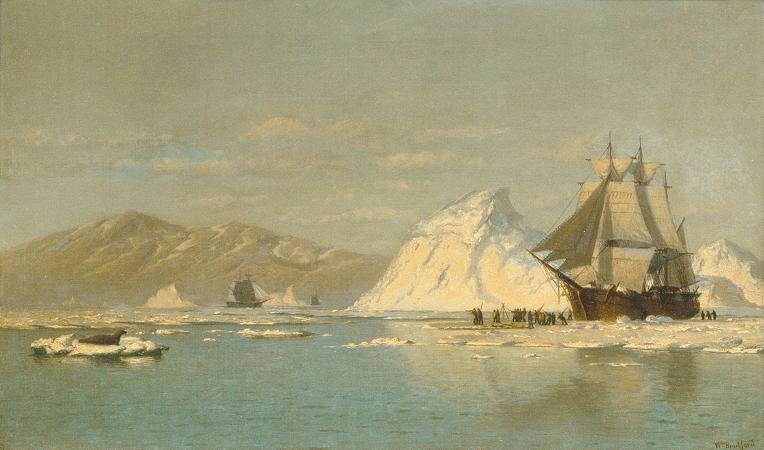Arctic. The Arctic is a polar region located at the northernmost part of Earth. The Arctic consists of the Arctic Ocean, adjacent seas, and parts of Alaska, Finland, Greenland, Iceland, Northern Canada, Norway, Russia and Sweden. Land within the Arctic region has seasonally varying snow and ice cover, with predominantly treeless permafrost containing tundra. Arctic seas contain seasonal sea ice in many places. The Arctic region is a unique area among Earth's ecosystems. For example, the cultures in the region and the Arctic indigenous peoples have adapted to its cold and extreme conditions. Life in the Arctic includes organisms living in the ice, zooplankton and phytoplankton, fish and marine mammals, birds, land animals, plants and human societies. Arctic land is bordered by the subarctic. The word Arctic comes from the Greek word, near the Bear, northern and that from the word, meaning bear. The name refers either to the constellation Ursa Major, the Great Bear, which is prominent in the northern portion of the celestial sphere, or to the constellation Ursa Minor, the Little Bear, which contains Polaris, the Pole star, also known as the North Star. There are a number of definitions of what area is contained within the Arctic. The area can be defined as north of the Arctic Circle, the approximate southern limit of the midnight sun and the polar night. Another definition of the Arctic is the region where the average temperature for the warmest month is below 10 °C; the northernmost tree line roughly follows the isotherm at the boundary of this region. Main articles: Climate of the Arctic and Global warming in the Arctic The Arctic's climate is characterized by cold winters and cool summers. Its precipitation mostly comes in the form of snow and is low, with most of the area receiving less than 50 cm. High winds often stir up snow, creating the illusion of continuous snowfall. Average winter temperatures can go as low as −40 °C, and the coldest recorded temperature is approximately −68 °C. Coastal Arctic climates are moderated by oceanic influences, having generally warmer temperatures and heavier snowfalls than the colder and drier interior areas. The Arctic is affected by current global warming, leading to Arctic sea ice shrinkage, diminished ice in the Greenland ice sheet, and Arctic methane release as the permafrost thaws. Due to the poleward migration of the planet's isotherms, the Arctic region is currently shrinking. Perhaps the most alarming result of this is Arctic sea ice shrinkage. There is a large variance in predictions of Arctic sea ice loss, with models showing near-complete to complete loss in September from 2040 to some time well beyond 2100. About half of the analyzed models show near-complete to complete sea ice loss in September by the year 2100. Arctic life is characterized by adaptation to short growing seasons with long periods of sunlight, and to cold, dark, snow-covered winter conditions. Arctic vegetation is composed of plants such as dwarf shrubs, graminoids, herbs, lichens, and mosses, which all grow relatively close to the ground, forming tundra. An example of a dwarf shrub is the Bearberry. As one moves northward, the amount of warmth available for plant growth decreases considerably. In the northernmost areas, plants are at their metabolic limits, and small differences in the total amount of summer warmth make large differences in the amount of energy available for maintenance, growth and reproduction. Colder summer temperatures cause the size, abundance, productivity and variety of plants to decrease. Trees cannot grow in the Arctic, but in its warmest parts, shrubs are common and can reach 2 m in height; sedges, mosses and lichens can form thick layers. In the coldest parts of the Arctic, much of the ground is bare; non-vascular plants such as lichens and mosses predominate, along with a few scattered grasses and forbs. Herbivores on the tundra include the Arctic hare, lemming, muskox, and caribou. They are preyed on by the snowy owl, Arctic fox, Grizzly bear, and Arctic wolf. The polar bear is also a predator, though it prefers to hunt for marine life from the ice. There are also many birds and marine species endemic to the colder regions. Other terrestrial animals include wolverines, moose, Dall sheep, ermines, and Arctic ground squirrels. Marine mammals include seals, walrus, and several species of cetacean, baleen whales and also narwhals, killer whales, and belugas.
more...






